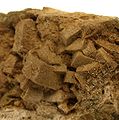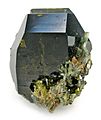Group silicates
As a group silicates (Sorosilikate) is referred to silicates , the silicate anions of groups of corner-sharing SiO 4 - tetrahedron consist. The groups are isolated; That is, they are not linked to one another via further Si-O bonds to form chains, layers or frameworks.
This division of the silicates includes petrologically interesting groups of minerals such as B. the Melilite -, Lawsonite -, Vesuvian - and Epidot group as well as zoisite .
The symmetry of the group silicates is usually low, predominantly monoclinic or triclinic, more rarely orthorhombic or tetragonal. Cubic group silicates are not known. The mineral karnasurtite (Ce), which belongs to the group silicates, is X-ray amorphous.
classification
Silicate classification according to Liebau
In Liebau's structural silicate classification, the group silicates, like the island silicates and ring silicates, belong to the silicates with dimensionality 0. The expansion of the silicate anions is not unlimited in any direction (0 dimensions).
Liebau divides the group silicates based on the structure of the silicate groups according to the following criteria:
Count:
It indicates how many silicate tetrahedra the groups consist of. Only the SiO 2 tetrahedra that form a linear chain fragment are counted . Further branching tetrahedra are not counted. The number of natural group silicates is 2 to 5.
2 single silicate group of Åkermanit
Triple single silicate group of Rosenhahnit
4th single silicate group of Akatoreite
Simple arsenatotrisilicate group of tiragalloite , AsO 4 tetrahedron highlighted in yellow
Medait simple vanadatopentasilicate group , VO 4 tetrahedron highlighted in orange
Multiplicity:
Similar to ring silicates , linear silicate groups can also be linked to form multiple groups. The multiplicity indicates how many groups are linked together to form a multiple group. So far, only one group silicate with a multiplicity of 2 is known ( Fencooperit ).
Openly branched triple silicate group of Fencooperit
Branching:
It indicates whether further SiO 4 tetrahedra branch off from the silicate chain . A distinction is made between openly branched silicates and cyclically branched silicates, in which the SiO 4 tetrahedra branching off the chain form closed rings.
Open branched single group of 3 of the Zunyit
Mixed silicate anions:
Many group silicates contain, in addition to a silicate group, further isolated island or group silicate anions . Epidote z. B. contains, in addition to an Si 2 O 7 group, an SiO 4 island silicate group.
Strunz
The 9th edition of Strunz's Mineralogical Tables divides the department of group silicates (9.B) primarily according to the number of silicate groups, then according to the occurrence of further isolated anion complexes and according to the structural environment of the cations.
- 9.BA Si 2 O 7 groups, without non-tetrahedral anions; Cations in tetrahedral [4] coordination
- 9.BB Si 2 O 7 groups, without non-tetrahedral anions; Cations in tetrahedral [4] and greater coordination
- 9.BC Si 2 O 7 groups, without non-tetrahedral anions; Cations in octahedral [6] and / or other coordination
- 9.BD Si 2 O 7 groups with additional anions; Cations in tetrahedral [4] and / or other coordination
- 9.BE Si 2 O 7 groups with additional anions; Cations in octahedral [6] and greater coordination
- 9.BF group silicates with mixed SiO 4 and Si 2 O 7 groups; Cations in tetrahedral [4] and greater coordination
- 9.BG group silicates with mixed SiO 4 and Si 2 O 7 groups; Cations in octahedral [6] and greater coordination
- 9.BH group silicates with Si 3 O 10 or larger anions; Cations in tetrahedral [4] and greater coordination
- 9.BJ group silicates with Si 3 O 10 , Si 4 O 11 etc. anions; Cations in octahedral [6] and / or greater coordination
See also
literature
- F. Liebau (1982): Classification of Silicates In: Reviews in Mineralogy. Volume 5: Orthosilicates; Mineralogical Society of America
Web links
- webmineral: Nickel-Strunz Silicates Classification (Version 10)
- Mineralienatlas : Mineral class-9.B according to Strunz 9th edition - group silicates (sorosilicates)
- mindat.org: Nickel-Strunz Classification - Sorosilicates 10th edition
- University of Tübingen: Systematics of the minerals
Individual evidence
- ↑ a b c d e f g Liebau 1982
- ↑ a b c d e Mineral class 9.B according to Strunz 9th edition
- ↑ a b c d Nickel-Strunz Silicates Classification (Version 10)
- ↑ a b c d Nickel-Strunz Classification - Sorosilicates 10th edition
- ↑ Karnasurtit: American Mineralogiste 45, 1960, pp. 1133-1134
- ↑ JD Grice: The Crystal Structure of Fencooperite : Unique [Fe 3+ 3 O 13 ] Pinwheels cross-connected by [Si 8 O 22 ] Islands, The Canadian Mineralogist 39 (2001), pp. 1065-1071












